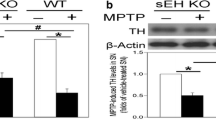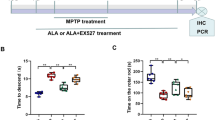Abstract
Soluble epoxide hydrolase (sEH) inhibition has been demonstrated to have beneficial effects on various diseases, such as hypertension, diabetes, and brain ischemia. However, whether sEH inhibition has therapeutic potential in Parkinson’s disease is still unknown. In this paper, we found that sEH expression is increased in 1-methyl-4-phenyl-1,2,3,6-tetrahydro pyridine (MPTP)-treated mice, and sEH deficiency and inhibition significantly attenuated tyrosine hydroxylase (TH)-positive cell loss and improved rotarod performance. The substrate of sEH, 14,15-epoxyeicosatrienoic acid (14,15-EET), protected TH-positive cells and alleviated the rotarod performance deficits of wild-type mice but not sEH-knockout mice. Moreover, the 14,15-EET antagonist 14,15-epoxyeicosa-5(Z)-enoic acid (14,15-EEZE) abolished the neuronal protective effects of sEH deficiency. In primary cultured cortical neurons, MPP+ induced significant Akt inactivation in neurons from sEH wild-type mice, and this effect was not observed in neurons from knockout mice. Our data indicate that sEH deficiency and inhibition increased 14,15-EET in MPTP-treated mice, which activated the Akt-mediated protection of TH-positive neurons and behavioral functioning. We also found that sEH deficiency attenuated TH-positive cell loss in a paraquat-induced mouse model of Parkinson’s. Our data suggest that sEH inhibition might be a powerful tool to protect dopaminergic neurons in Parkinson’s disease.







Similar content being viewed by others
References
Morisseau C, Hammock BD (2013) Impact of soluble epoxide hydrolase and epoxyeicosanoids on human health. Annu Rev Pharmacol Toxicol 53:37–58
Sura P, Sura R, Enayetallah AE, Grant DF (2008) Distribution and expression of soluble epoxide hydrolase in human brain. J Histochem Cytochem 56(6):551–559
Luo B, Norris C, Bolstad ES, Knecht DA, Grant DF (2008) Protein quaternary structure and expression levels contribute to peroxisomal-targeting-sequence-1-mediated peroxisomal import of human soluble epoxide hydrolase. J Mol Biol 380(1):31–41
Revermann M (2010) Pharmacological inhibition of the soluble epoxide hydrolase—from mouse to man. Curr Opin Pharmacol 10(2):173–178
Sudhahar V, Shaw S, Imig JD (2010) Epoxyeicosatrienoic acid analogs and vascular function. Curr Med Chem 17(12):1181–1190
Luria A, Bettaieb A, Xi Y, Shieh GJ, Liu HC, Inoue H, Tsai HJ, Imig JD, Haj FG, Hammock BD (2011) Soluble epoxide hydrolase deficiency alters pancreatic islet size and improves glucose homeostasis in a model of insulin resistance. Proc Natl Acad Sci U S A 108(22):9038–9043
Roman RJ (2002) P-450 metabolites of arachidonic acid in the control of cardiovascular function. Physiol Rev 82(1):131–185
Imig JD (2005) Epoxide hydrolase and epoxygenase metabolites as therapeutic targets for renal diseases. Am J Physiol Ren Physiol 289(3):F496–503
Imig JD (2012) Epoxides and soluble epoxide hydrolase in cardiovascular physiology. Physiol Rev 92(1):101–130
Eriksen JL, Wszolek Z, Petrucelli L (2005) Molecular pathogenesis of Parkinson disease. Arch Neurol 62(3):353–357
Gupta A, Dawson VL, Dawson TM (2008) What causes cell death in Parkinson’s disease? Ann Neurol 64(Suppl 2):S3–15
Sinal CJ, Miyata M, Tohkin M, Nagata K, Bend JR, Gonzalez FJ (2000) Targeted disruption of soluble epoxide hydrolase reveals a role in blood pressure regulation. J Biol Chem 275(51):40504–40510
Tomac A, Lindqvist E, Lin LF, Ogren SO, Young D, Hoffer BJ, Olson L (1995) Protection and repair of the nigrostriatal dopaminergic system by GDNF in vivo. Nature 373(6512):335–339
McCormack AL, Thiruchelvam M, Manning-Bog AB, Thiffault C, Langston JW, Cory-Slechta DA, Di Monte DA (2002) Environmental risk factors and Parkinson’s disease: selective degeneration of nigral dopaminergic neurons caused by the herbicide paraquat. Neurobiol Dis 10(2):119–127
Xia Z, Dudek H, Miranti CK, Greenberg ME (1996) Calcium influx via the NMDA receptor induces immediate early gene transcription by a MAP kinase/ERK-dependent mechanism. J Neurosci 16(17):5425–5436
Chen JK, Capdevila J, Harris RC (2001) Cytochrome p450 epoxygenase metabolism of arachidonic acid inhibits apoptosis. Mol Cell Biol 21(18):6322–6331
Liu M, Hunter R, Nguyen XV, Kim HC, Bing G (2008) Microsomal epoxide hydrolase deletion enhances tyrosine hydroxylase phosphorylation in mice after MPTP treatment. J Neurosci Res 86(12):2792–2801
Bellien J, Joannides R (2013) Epoxyeicosatrienoic acid pathway in human health and diseases. J Cardiovasc Pharmacol 61(3):188–196
Zhang W, Koerner IP, Noppens R, Grafe M, Tsai HJ, Morisseau C, Luria A, Hammock BD, Falck JR, Alkayed NJ (2007) Soluble epoxide hydrolase: a novel therapeutic target in stroke. J Cereb Blood Flow Metab 27(12):1931–1940
Koerner IP, Jacks R, DeBarber AE, Koop D, Mao P, Grant DF, Alkayed NJ (2007) Polymorphisms in the human soluble epoxide hydrolase gene EPHX2 linked to neuronal survival after ischemic injury. J Neurosci 27(17):4642–4649
Zhang W, Otsuka T, Sugo N, Ardeshiri A, Alhadid YK, Iliff JJ, DeBarber AE, Koop DR, Alkayed NJ (2008) Soluble epoxide hydrolase gene deletion is protective against experimental cerebral ischemia. Stroke 39(7):2073–2078
Dunnett SB, Bjorklund A (1999) Prospects for new restorative and neuroprotective treatments in Parkinson’s disease. Nature 399(6738 Suppl):A32–39
Seubert JM, Sinal CJ, Graves J, DeGraff LM, Bradbury JA, Lee CR, Goralski K, Carey MA, Luria A, Newman JW, Hammock BD, Falck JR, Roberts H, Rockman HA, Murphy E, Zeldin DC (2006) Role of soluble epoxide hydrolase in postischemic recovery of heart contractile function. Circ Res 99(4):442–450
Imig JD, Zhao X, Capdevila JH, Morisseau C, Hammock BD (2002) Soluble epoxide hydrolase inhibition lowers arterial blood pressure in angiotensin II hypertension. Hypertension 39(2 Pt 2):690–694
Acknowledgments
We thank Dr. Bruce D. Hammock for kindly providing the sEH antibody. This work was supported by the National Natural Science Foundation of China (81071016), the Program for New Century Excellent Talents in University (NCET-12-0647), the Key Project of Guangdong Province (CXZD1018), and the Program for Changjiang Scholars and the Innovative Research Team in University (IRT1142). The authors declare that they have no conflicts of interest.
Author information
Authors and Affiliations
Corresponding author
Additional information
Xiaocui Qin and Qiaoqi Wu contributed equally to this work.
Rights and permissions
About this article
Cite this article
Qin, X., Wu, Q., Lin, L. et al. Soluble Epoxide Hydrolase Deficiency or Inhibition Attenuates MPTP-Induced Parkinsonism. Mol Neurobiol 52, 187–195 (2015). https://doi.org/10.1007/s12035-014-8833-3
Received:
Accepted:
Published:
Issue Date:
DOI: https://doi.org/10.1007/s12035-014-8833-3




